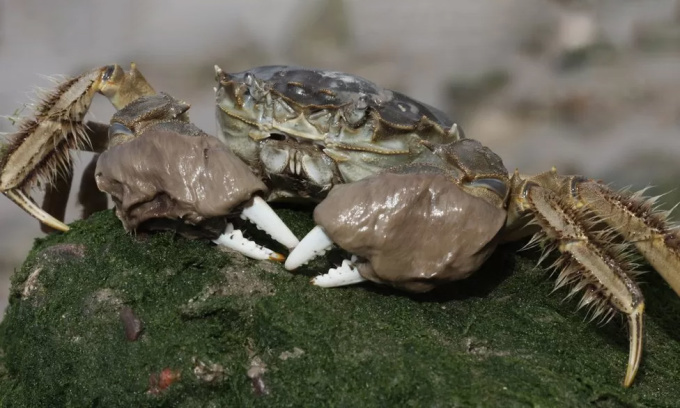Chinese hairy crabs - an invasive species with increasing numbers so the government is advising people in the UK to report sightings.

Chinese hairy crabs can grow as large as dinner plates and have distinctive hairs on their legs. Photo: Mikelane45/Getty
The Chinese hairy crab ( Eriocheir sinensis ), also known as the eggplant or Shanghai hairy crab, is a crustacean native to East Asia, New Scientist reported on October 13. They are characterized by their glove-like, hairy claws. Their bodies are blue-gray or dark brown, and they typically grow to about 8 centimeters (3 inches) long, but their legs can stretch twice that far.
Over the past century, Chinese hairy crabs have spread to many areas of the world , including Europe and North America, where they are considered an invasive species. They typically live in freshwater environments such as rivers, canals, and estuaries.
Chinese hairy crabs can damage the environment by burrowing into riverbeds, blocking waterways and damaging fishing gear with their sharp pincers. Experts also worry that they may eat fish eggs and take resources away from native species.
The crab was first discovered in the UK in 1935 in the River Thames. Since then, it has been found all over the UK. Recently, people have even seen a number of hairy crabs crawling around the waters of Cambridgeshire.
The Natural History Museum is running a “Hairy Crab Watch” campaign, urging people to report sightings. The Department for Food, Agriculture and Rural Affairs is also encouraging people to report hairy crab sightings. This can help experts monitor populations and prevent the movement of eggs.
"Their numbers are increasing because they have a very unusual lifestyle. After migrating downstream, adult females can lay three clutches of eggs," explains Paul Clark, an expert at the Natural History Museum. Each clutch can contain 500,000 to 1,000,000 eggs, Clark says.
In a bid to tackle the growing hairy crab population in the UK, Lincolnshire Wildlife Trust, Welland and Deepings Drainage Authority and the Natural History Museum teamed up to install the first permanent hairy crab trap in Pode Hole, Lincolnshire, in August.
Thu Thao (According to New Scientist )
Source link

























































![[Maritime News] Treasury Department Targets Diverse Networks Facilitating Iran's Oil Trade](https://vphoto.vietnam.vn/thumb/402x226/vietnam/resource/IMAGE/2025/7/14/43150a0498234eeb8b127905d27f00b6)












































Comment (0)